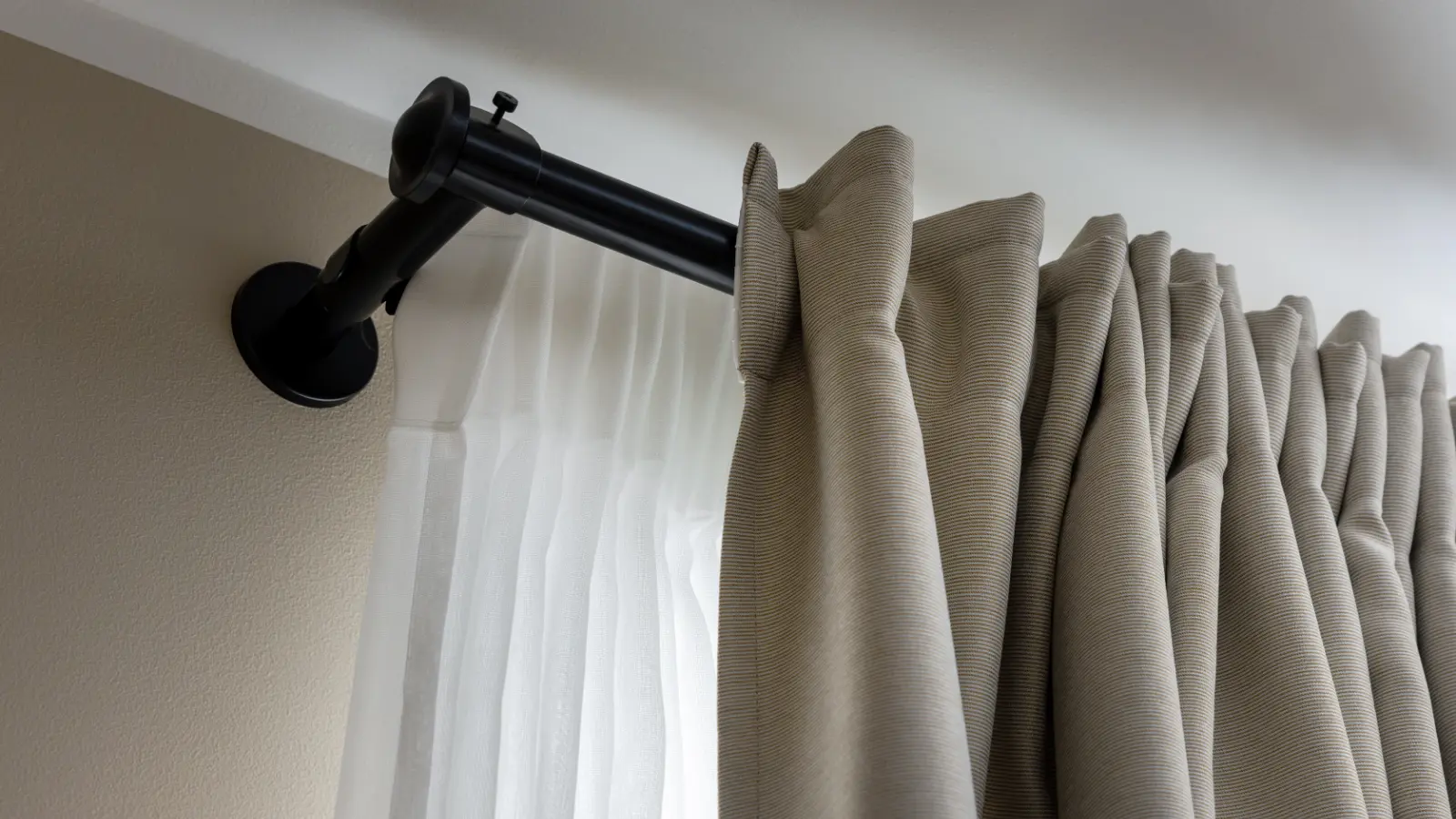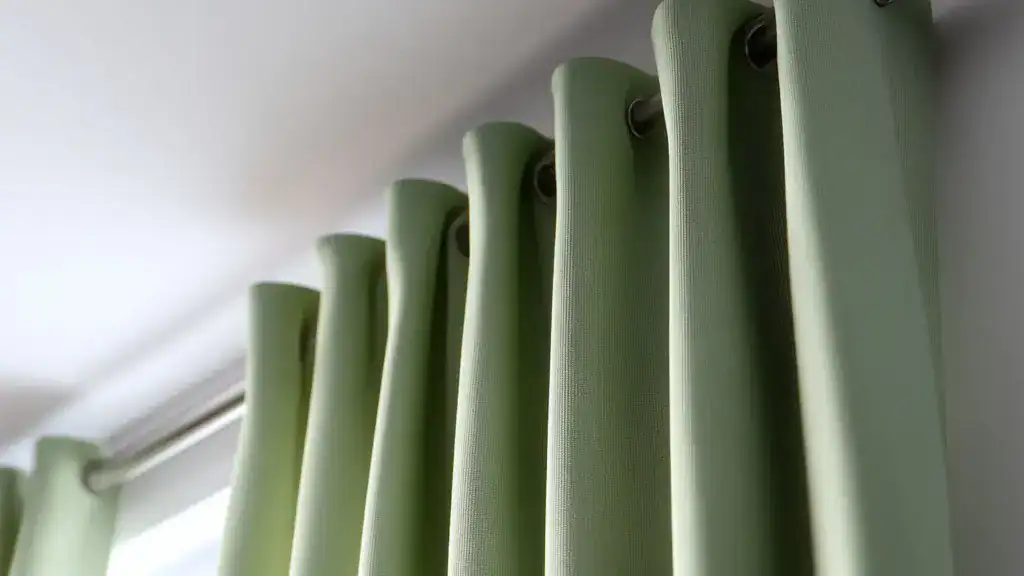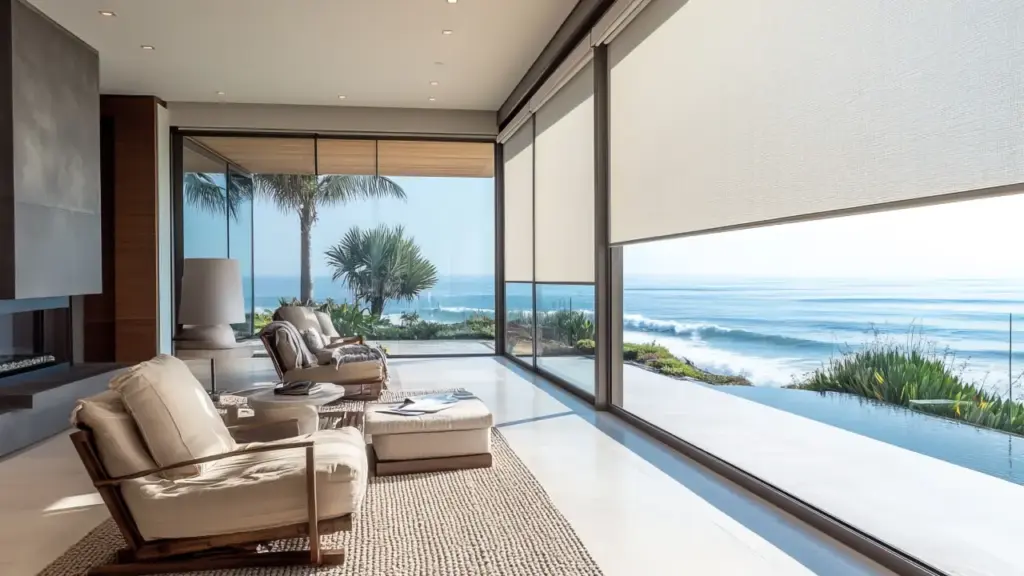Layered Window Treatments for Style & Functionality: Expert Tips

Nothing’s better than a great window treatment to transform a room.
Except maybe two great window treatments layered into one.
Here, we’re only mildly facetious — because layered window treatments are an easy and inexpensive way to take your home decor up a notch. Plus, there’s a boatload of practical reasons for layering window treatments.
Whether you’re new to the concept of layering or just looking for ideas, we’ve got you covered. Let’s dive into the mysterious world of layered window treatments to discover the perfect balance of style and function.
What’s a Layered Window Treatment?
A layered window treatment combines different types of window coverings on the same window to achieve a unique look and utility. It’s all about doubling up — think of it as accessorizing your windows.
For instance, you could pair a light-filtering sheer curtain with a heavier, blackout drape to enjoy soft, diffused light during the day and complete privacy at night.
Or maybe you fancy a classic combo of wood blinds with a fabric valance on top for visual interest and a pop of color. The possibilities are endless, and the payoff is huge.
Layered treatments give your room a polished look while providing greater control over light and privacy. Très cool, n’est-ce pas?
Why Layer Window Treatments?
- Design Flexibility: With layering, you can mix and match colors, textures, and materials for a truly custom look.
- Better Functionality: You’ll enjoy the benefits of two or more window treatments. For example, layering a sheer curtain over a Roman shade allows superior light filtration and excellent privacy control.
- Energy Efficiency: Layered window treatments offer better insulation against heat and cold. Double the coverings, double the efficiency!
- Noise Reduction: Combining thicker materials can help absorb sound and reduce outside noise.
- Added Privacy: Multiple layers shield you more from prying eyes. This is especially useful for bedrooms or rooms facing busy streets.
The Art of Layering
Layering usually involves curtains or drapes in combination with something else.
Layering blinds with shades makes little sense (what’s the point?), and combining shutters with shades is a prime example of overkill.
More likely, you’d match heavy drapes with sheer curtains, decorative curtains with roller shades, and so on.
Curtains and drapes frame the window and add softness, while shades, blinds, or shutters provide privacy and light control.
1. Choosing the Right Fabrics
Heavier fabrics like velvet and brocade project opulence and a rich, luxurious aesthetic. These are perfect for more formal settings or making a grand statement.
On the other hand, lightweight fabrics like linen and sheers create an airy, relaxed ambiance. These are great for casual, beachy, or minimalist aesthetics, allowing natural light to filter through while maintaining privacy.
Your fabric choices should align with the overall style and purpose of the room.
2. Combining Curtains & Blinds
Blinds and curtains are a power duo.
Curtains are the style-makers, the room-softeners, and color poppers, with their distinctive flow and textural appeal.
Blinds are the masters of natural light control. Whether wooden, aluminum, or fabric blinds, they bring a clean, structured look to your windows.
By teaming them up, you get the elegance of curtains with the functionality of blinds. The combo works with nearly any design style, from modern to rustic, traditional to eclectic.
3. Layering with Valances & Drapes
Valances top off your existing curtains or drapery, framing the window with a decorative flair and hiding unsightly hardware. They come in various sizes and shapes.
A simple, tailored valance in a solid color lends sophistication to your layered treatment. You could also opt for a more elaborate design with pleats, ruffles, or trims.
Another idea is layering draperies over sheer shades or blinds. The semi-opaque fabric of the shade filters light and preserves privacy while allowing the drapery’s rich texture and color to shine through.
Pro-tip: When layering valances with drapes, opt for a simple yet bold pattern or add texture with a geometric print to avoid clashing.
4. Layering Roman Shades & Curtains
Roman shades and curtains blend form and function flawlessly.
The clean, practical utility of Roman shades combined with the softness and elegance of curtains creates a versatile window treatment that works in almost any room style.
Roman shades provide excellent light control and privacy, while curtains can add color, pattern, or texture to your space.
Consider a neutral, solid-color Roman shade with a patterned curtain for balanced visual interest, or match a textured shade with a sheer curtain for a subtle play on light and shadow.
The key to success lies in the harmony of materials, colors, and patterns.
5. Layering Sheer Curtains
Sheer curtains are like a subtle whisper that screams elegance. They soften a room with ethereal beauty and a light, airy atmosphere.
Their translucency makes them ideal for layering, allowing you to enjoy natural light while maintaining a degree of privacy.
You can pair them with heavier drapes for insulation and more privacy and light control.
Layer sheers with string lights or drape them over a canopy bed for a dreamy, romantic look.
6. Playing With Patterns & Colors
Whether you’re a fan of bold, vibrant patterns or more inclined towards subtle, calming hues, the world is your oyster when it comes to mixing and matching patterns and colors.
Stick with two or three complementary colors for a cohesive look, or go wild with contrasting shades for a punchy, eclectic vibe. Remember, the key is balance.
If you opt for a patterned curtain, consider solid shades or blinds to avoid overwhelming the eye. But if your blinds or shades are patterned, keep your curtains in a solid, coordinating color.
7. Layering for Energy Efficiency
Here, it’s all about combining insulating materials; cellular shades are a top pick.
Also known as honeycomb shades, these bad boys are specially designed with pockets that trap air, creating a barrier between your window and your room. Less heat leaks in during summer, and less warmth escapes in winter.
Layer cellular shades with curtains or drapes for style and insulation. Your gorgeous window treatment may even earn you a tax credit (for the shades)!
8. Achieving Balance
Balance is the cornerstone of successful layering.
This doesn’t mean slavish adherence to a monotonous, uniform look. The idea is to blend different textures, colors, and designs harmoniously to create a functional and aesthetically pleasing treatment.
Test out different combinations, and don’t be afraid to experiment. Layering window treatments is like creating a culinary masterpiece — it involves trial and error and fine-tuning until you hit that sweet spot.
So, go forth and layer fearlessly! Transform your windows into works of art that reflect your style and personality.
Creative Layering Ideas
Classic Elegance
Combine a set of heavy drapes with sheer curtains for a timeless and elegant look. This style suits formal living rooms and dining areas.
Casual Comfort
For a cozy and informal ambiance, pair Roman shades with lightweight curtains. This combination is perfect for bedrooms and family rooms.
Bohemian Chic
Embrace a bohemian vibe by layering patterned curtains with bamboo blinds. This eclectic style works well in sunrooms and kitchens.
Minimalist Simplicity
Opt for a clean, uncluttered appearance by pairing roller shades with a simple valance. This minimalist style is ideal for modern interiors.
Rustic Charm
Combine wooden blinds with a burlap or linen curtain for a rustic, country feel. It’s perfect for farmhouse-style kitchens and bedrooms.
Glamorous Drama
Create a grand statement by layering heavy velvet drapes over sheer curtains. This luxurious style suits formal dining rooms and master bedrooms.
Installation Tips
Proper Measurements
- Allow for overlap on each side, top, and bottom to control light bleed and maintain privacy.
- Measure twice, just to be sure, since a small mistake could mean a big problem when your treatments arrive.
Mounting Hardware
- Consider the weight of your chosen coverings.
- Heavier drapes require sturdy rods and brackets.
- Lighter curtains or shades can get by with less robust hardware.
- Choose hardware that complements your window treatments and fits your room’s decor.
- Try metal or wooden rods for a classic look.
- Low-profile tracks offer a modern or minimalist vibe.
- Distressed wood and wrought iron exude rustic charm.
- Remember the finials — those ornamental ends on your curtain rods that can add a delightful dash of personality.
Calling in the Layering Experts
If you’re unsure what to do or lack confidence in your creative abilities, it may be time to call in the pros.
In Los Angeles, that means calling Aero Shade, the most trusted (and one of the oldest) window treatments in Southern California.
We’ve handled the window treatments for prominent architects and designers, Hollywood celebrities, and thousands of homeowners in the LA basin.
We manufacture custom curtains in our shop and sell customized versions from top manufacturers.
And, of course, we offer all the window treatments and accessories you may need for layering, from cellular shades to wooden blinds.
Call us today for a free in-home estimate. 323-457-2835.
FAQs: More aout Layered Window Treatments
Q: Can I layer window treatments in any room?
Yes, you can layer window treatments in any room. You can apply the technique in living rooms, bedrooms, kitchens, and even bathrooms.
Q: Are there certain color combinations that work best for layering?
There are no strict color combination rules. However, choose colors that complement your room’s palette and mood. Consider cool tones like blues and greens for a serene, calming effect. Warm colors like oranges and reds create a cozy, vibrant atmosphere. Neutrals can blend with virtually any style or mood.
Q: Is layering window treatments cost-effective?
Layered window treatments can be cost-effective because they can combine budget-friendly and high-end options to achieve the desired look and functionality.
Q: How do I clean and maintain layered window treatments?
Cleaning and maintenance depend on the materials used. Follow the care instructions for each component, such as curtains, blinds, or shades.
Q: Can I layer window treatments in a small space?
Yes, you can layer window treatments in a small space. The trick is to maintain a sense of proportion and choose window coverings that don’t overwhelm the room.
Q: What is the latest trend in layering window treatments?
Current trends include using natural materials like bamboo shades and the combination of patterned curtains with solid-colored blinds or shades.
Q: What are the benefits of using sheer curtains in layering?
Sheer curtains provide a soft, diffused light and maintain privacy while lending elegance to your space.
Q: Do I need professional help to install layered window treatments?
While it’s possible to install layered treatments on your own, professional help can ensure a flawless and secure installation.
Q: Can I layer window treatments with different operating mechanisms?
You can layer window treatments with different operating mechanisms if they fit your window and work well together aesthetically.
Q: Can I layer different types of window treatments on the same window?
Layering curtains, blinds, and sheers can create a stylish look. Consider combining different textures and opacities.
Q: What is the recommended order for layering window treatments?
For functionality, start with the base layer, such as blinds or shades. Add curtains or drapes for style and finish with valances or cornices for a polished look.
Q: Are there specific styles that work best for layered window treatments?
Roman shades, roller shades, and wooden blinds are excellent base layers. Try grommet curtains, sheer panels, or valances for the upper layers.
Q: Do layered window treatments help with energy efficiency?
Yes, mainly if you use heavier fabrics like thermal curtains or cellular shades. Layering creates an additional barrier against drafts, improving insulation and energy efficiency.
Q: How do I measure my windows for layered treatments?
Measure the width and height for each layer separately. Ensure that each layer complements the others, and consider the stacking or bunching of each treatment when fully opened.
Q: Can I layer window treatments in a minimalist design?
Certainly. Choose simple and sleek designs for blinds or shades, and opt for neutral-colored curtains or sheer panels. The point is to maintain a clean and uncluttered aesthetic.
Q: What are the common mistakes to avoid when layering window treatments?
Avoid overcrowding the window with too many layers. Ensure each layer complements the others in color, pattern, and functionality.
Q: Can layered window treatments be motorized for convenience?
Yes, many window treatment options, including blinds and shades, can be motorized. Motorization adds convenience, especially for hard-to-reach windows or oversized windows.


